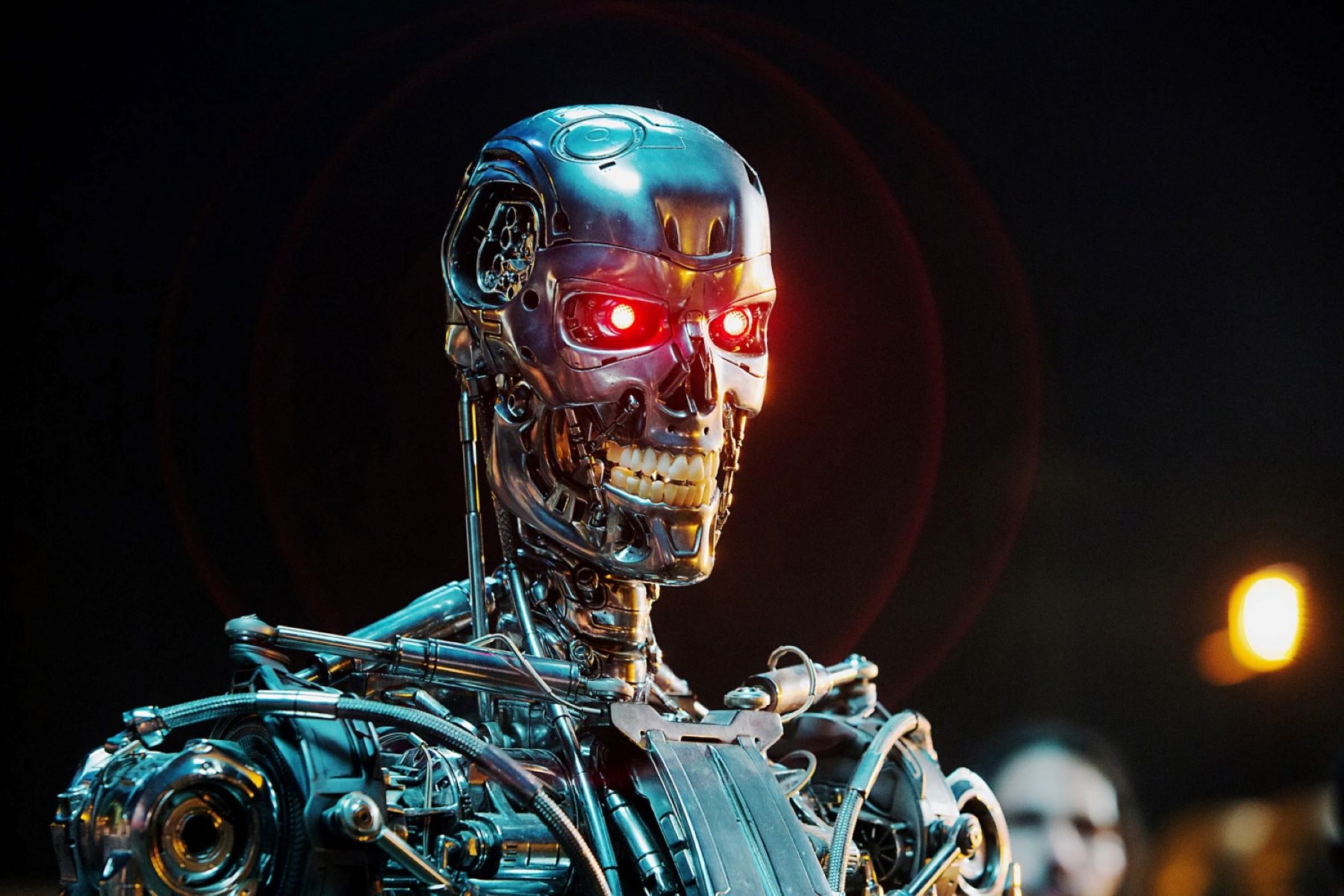Home>Technology and Computers>10 Surprising Tasks Robots Can Do!


Technology and Computers
10 Surprising Tasks Robots Can Do!
Published: February 17, 2024
Discover 10 surprising tasks robots can perform in the field of technology and computers. Explore the latest advancements in robotics and automation.
(Many of the links in this article redirect to a specific reviewed product. Your purchase of these products through affiliate links helps to generate commission for Regretless.com, at no extra cost. Learn more)
Table of Contents
Introduction
In today's rapidly advancing technological landscape, robots are no longer confined to the realms of science fiction. They have seamlessly integrated into various aspects of our lives, revolutionizing industries and transforming the way we accomplish tasks. From performing intricate surgeries to assisting with household chores, robots have proven to be incredibly versatile, efficient, and capable of undertaking a wide array of surprising tasks.
As we delve into the realm of robotics, it becomes increasingly evident that their capabilities extend far beyond our initial perceptions. The integration of artificial intelligence and advanced robotics has paved the way for groundbreaking innovations, enabling robots to excel in tasks that were once deemed exclusive to human expertise. These advancements have not only broadened the scope of what robots can achieve but have also opened up new possibilities for enhancing productivity and efficiency across diverse sectors.
The following sections will explore ten surprising tasks that robots can proficiently undertake, shedding light on their remarkable capabilities and the impact they have on various industries and aspects of daily life. From the operating theater to the kitchen, from educational settings to customer service interactions, the influence of robots continues to expand, presenting opportunities for enhanced precision, automation, and support across a multitude of domains. Let's embark on a journey to uncover the remarkable feats achieved by robots, showcasing their ability to transcend traditional boundaries and redefine the possibilities of technology in our modern world.
Performing Surgery
Robotic technology has made significant strides in the field of surgery, offering unprecedented precision and enhancing patient outcomes. With the advent of robotic surgical systems, such as the da Vinci Surgical System, complex procedures can be performed with remarkable accuracy and dexterity. These systems are equipped with advanced robotic arms that are controlled by surgeons, allowing for minimally invasive procedures with enhanced visualization and precise movements.
The robotic arms used in surgery are designed to mimic the natural range of motion of a human hand, but with a greater degree of flexibility and control. This enables surgeons to navigate intricate anatomical structures with unparalleled precision, reducing the risk of damage to surrounding tissues and minimizing post-operative complications. Additionally, the enhanced visualization provided by robotic systems allows surgeons to operate with a high level of accuracy, even in confined spaces within the body.
One of the key advantages of robotic surgery is the ability to perform minimally invasive procedures, resulting in smaller incisions, reduced blood loss, and faster recovery times for patients. This is particularly beneficial in procedures such as prostatectomies, hysterectomies, and cardiac surgeries, where precision and minimal disruption to surrounding tissues are crucial.
Moreover, robotic surgery has expanded access to specialized surgical expertise, as it enables surgeons to remotely operate on patients located in different geographical locations. This has proven to be especially valuable in scenarios where patients require urgent surgical intervention but may not have immediate access to a specialist in their vicinity.
The integration of robotic technology in surgery represents a remarkable advancement in the medical field, offering a combination of precision, efficiency, and improved patient outcomes. As technology continues to evolve, the potential for robotic systems to further enhance surgical capabilities and expand the scope of procedures that can be performed with precision and safety is indeed promising.
Cooking
Robots have made significant inroads in the culinary world, showcasing their ability to undertake intricate cooking tasks with precision and consistency. The integration of robotics in cooking processes has revolutionized the food industry, offering innovative solutions for commercial kitchens and home environments alike.
One of the most notable applications of robotic technology in cooking is the automation of repetitive tasks, such as chopping, slicing, and dicing ingredients. Robotic food processors and kitchen assistants are equipped with advanced sensors and algorithms that enable them to execute these tasks with remarkable speed and accuracy, significantly reducing the time and effort required for food preparation.
Furthermore, robotic cooking systems have been developed to handle more complex culinary endeavors, including grilling, frying, and baking. These systems are designed to replicate the techniques and expertise of professional chefs, ensuring that dishes are prepared to perfection consistently. By leveraging precise temperature control and cooking parameters, robotic cooking systems can create a diverse range of culinary delights with unparalleled precision, catering to the specific preferences and dietary requirements of consumers.
In addition to their prowess in food preparation, robots have also been employed in the assembly and packaging of food products, streamlining production processes in commercial food manufacturing facilities. Automated systems can efficiently handle tasks such as portioning, sorting, and packaging food items, contributing to enhanced efficiency and quality control in food production operations.
The integration of robotics in cooking not only enhances the speed and accuracy of food preparation but also contributes to improved food safety and hygiene standards. Automated systems are designed to adhere to strict sanitation protocols and minimize the risk of cross-contamination, ensuring that food products meet stringent quality and safety standards.
Moreover, the utilization of robotic cooking systems has the potential to address labor shortages in the food industry, particularly in environments where repetitive and labor-intensive tasks are prevalent. By automating these tasks, businesses can optimize their operational efficiency and allocate human resources to more specialized and creative aspects of culinary endeavors.
As robotic technology continues to evolve, the possibilities for its application in cooking are boundless. The integration of artificial intelligence and machine learning algorithms holds the promise of further enhancing the capabilities of robotic cooking systems, enabling them to adapt to evolving culinary trends and consumer preferences seamlessly.
The advent of robotic cooking systems represents a paradigm shift in the culinary landscape, offering a glimpse into a future where precision, efficiency, and creativity converge to redefine the art of cooking.
Cleaning
In the realm of household and commercial maintenance, robots have emerged as formidable allies in the ongoing battle against dirt, grime, and clutter. The integration of robotic technology in cleaning processes has revolutionized the way spaces are maintained, offering efficient and precise solutions for a myriad of cleaning tasks.
Robotic vacuum cleaners, equipped with advanced sensors and navigation systems, are designed to autonomously traverse indoor environments, meticulously removing dust, debris, and pet dander from floors and carpets. These intelligent cleaning devices are capable of mapping out the layout of a space, identifying obstacles, and adapting their cleaning patterns to ensure comprehensive coverage. By leveraging a combination of suction power, brushes, and filters, robotic vacuum cleaners efficiently maintain pristine flooring surfaces, all while alleviating the burden of manual vacuuming for users.
Beyond floor maintenance, robotic technology has extended its reach to encompass other cleaning domains, including window washing and outdoor surface cleaning. Robotic window cleaners are equipped with suction mechanisms and precision control systems, enabling them to ascend vertical surfaces and eradicate streaks and smudges with unparalleled accuracy. Similarly, outdoor cleaning robots are designed to navigate outdoor environments, such as sidewalks and pavements, effectively removing dirt, leaves, and other debris to uphold cleanliness and safety in public spaces.
The utilization of robotic cleaning systems in commercial settings, such as offices and industrial facilities, has significantly enhanced the efficiency and consistency of cleaning operations. Automated floor scrubbers and sweepers are equipped with advanced cleaning mechanisms and intuitive navigation systems, enabling them to maintain large floor areas with precision and speed. These robotic cleaning solutions contribute to improved hygiene standards and workplace safety, while also optimizing the allocation of human resources to more specialized tasks.
Moreover, the integration of artificial intelligence and machine learning algorithms in robotic cleaning systems holds the promise of further enhancing their capabilities. By analyzing cleaning patterns, identifying high-traffic areas, and adapting to specific cleaning requirements, robotic cleaners can optimize their performance and deliver tailored cleaning solutions to meet diverse needs.
The integration of robotics in cleaning processes represents a significant leap forward in the quest for efficient and sustainable maintenance solutions. As technology continues to evolve, the potential for robotic cleaning systems to further streamline cleaning operations and elevate hygiene standards across various environments is indeed promising.
Providing Therapy
The integration of robotic technology in the realm of therapy has ushered in a new era of innovative solutions for addressing diverse physical and psychological needs. Robots designed to provide therapy are equipped with advanced capabilities that enable them to engage with individuals in a manner that promotes emotional well-being, physical rehabilitation, and cognitive stimulation.
In the context of physical therapy, robotic systems have demonstrated remarkable efficacy in assisting individuals with mobility impairments and musculoskeletal conditions. Robotic exoskeletons, for instance, are designed to support and augment the movements of individuals undergoing rehabilitation, enabling them to regain strength, mobility, and coordination. These exoskeletons are equipped with sensors and actuators that respond to the user's movements, providing targeted assistance and resistance to facilitate gait training and muscle re-education. By offering personalized and adaptive support, robotic exoskeletons contribute to accelerated recovery and improved functional outcomes for individuals undergoing rehabilitation.
Additionally, robotic therapy devices have been developed to aid in the rehabilitation of individuals recovering from neurological injuries or conditions. Robotic-assisted therapy for stroke survivors, for example, encompasses the use of devices that facilitate repetitive and targeted movements to promote motor recovery and neurological reorganization. These devices leverage interactive interfaces and biofeedback mechanisms to engage patients in tailored rehabilitation exercises, fostering neuroplasticity and enhancing motor control and coordination.
In the realm of mental health and emotional well-being, robots have been employed to provide companionship and support for individuals facing social isolation, cognitive decline, or emotional distress. Socially assistive robots, equipped with interactive communication capabilities and emotional recognition algorithms, engage with individuals in a manner that fosters social interaction, cognitive stimulation, and emotional expression. These robots offer companionship, engage users in cognitive exercises, and provide emotional support, contributing to improved mental well-being and quality of life for individuals in need of social and emotional companionship.
The integration of artificial intelligence and machine learning algorithms in robotic therapy systems holds the potential to further personalize and optimize therapy interventions. By analyzing user responses, adapting to individual progress, and tailoring therapeutic interactions, robotic therapy systems can offer tailored support and rehabilitation strategies that cater to the unique needs and preferences of each individual.
In essence, the utilization of robotic technology in therapy represents a paradigm shift in the delivery of rehabilitative and supportive interventions. As these technologies continue to evolve, the potential for robotic therapy systems to enhance physical rehabilitation, promote emotional well-being, and address diverse therapeutic needs is indeed promising, offering a glimpse into a future where personalized and effective therapy interventions are accessible to a broader spectrum of individuals.
Read more: 10 Fun Things To Do In Santa Rosa, CA
Farming
The integration of robotic technology in the agricultural sector has ushered in a new era of innovation and efficiency, revolutionizing the way farming operations are conducted. Robotic systems designed for farming applications encompass a diverse range of capabilities, offering solutions for tasks such as planting, harvesting, crop monitoring, and precision agriculture.
One of the most notable applications of robots in farming is the automation of planting and harvesting processes. Agricultural robots equipped with advanced planting mechanisms and autonomous navigation systems can efficiently sow seeds and transplant seedlings with precision and consistency. These robotic systems optimize the allocation of seeds and ensure uniform spacing, contributing to improved crop yields and resource utilization. Similarly, robotic harvesters have demonstrated remarkable efficacy in autonomously collecting ripe fruits, vegetables, and crops, streamlining harvesting operations and alleviating labor-intensive tasks for farmers.
In addition to planting and harvesting, robotic technology has been leveraged for crop monitoring and management. Unmanned aerial vehicles (UAVs) equipped with imaging sensors and data analytics capabilities are employed to conduct aerial surveys of farmland, enabling farmers to assess crop health, identify areas of concern, and make informed decisions regarding irrigation, fertilization, and pest control. By leveraging real-time data and aerial imagery, agricultural robots contribute to enhanced crop management and yield optimization, empowering farmers with actionable insights to maximize productivity.
Furthermore, the integration of robotic systems in precision agriculture has redefined the approach to farming practices. Autonomous tractors and robotic implements are equipped with GPS-guided navigation and precision control systems, enabling them to perform tasks such as plowing, seeding, and spraying with unparalleled accuracy. These robotic solutions minimize the environmental impact of farming operations, optimize the use of resources, and contribute to sustainable agricultural practices.
The utilization of robotic technology in farming not only enhances operational efficiency but also addresses labor shortages and the evolving demands of modern agriculture. By automating labor-intensive tasks and offering precise management solutions, agricultural robots empower farmers to optimize their operations, reduce operational costs, and adapt to dynamic agricultural landscapes.
As robotic technology continues to evolve, the potential for further advancements in agricultural robotics holds promise for the future of farming. The integration of artificial intelligence and machine learning algorithms in robotic farming systems has the potential to enhance predictive analytics, crop modeling, and autonomous decision-making, further optimizing farming practices and contributing to global food security.
The integration of robotic technology in farming represents a significant leap forward in the quest for sustainable and efficient agricultural practices. As these technologies continue to evolve, the potential for robotic farming systems to further streamline farming operations and elevate productivity across diverse agricultural domains is indeed promising, offering a glimpse into a future where precision, efficiency, and sustainability converge to redefine the landscape of modern agriculture.
Performing Household Chores
The integration of robotic technology in the domain of household chores has redefined the landscape of home maintenance, offering innovative solutions for streamlining domestic tasks and alleviating the burden of routine cleaning and upkeep. Robotic systems designed for household chores encompass a diverse array of capabilities, ranging from floor cleaning and lawn maintenance to laundry assistance and smart home management.
Robotic vacuum cleaners have emerged as indispensable allies in the quest for pristine indoor environments. These intelligent cleaning devices are equipped with advanced sensors and navigation systems, enabling them to autonomously traverse floors and carpets, meticulously removing dust, debris, and pet dander. By leveraging a combination of suction power, brushes, and filters, robotic vacuum cleaners efficiently maintain pristine flooring surfaces, all while alleviating the burden of manual vacuuming for users. Furthermore, robotic mops and floor scrubbers have revolutionized the task of floor maintenance, offering automated solutions for maintaining sparkling clean surfaces with minimal user intervention.
Beyond indoor cleaning, robotic technology has extended its reach to encompass outdoor maintenance tasks, including lawn mowing and garden upkeep. Robotic lawn mowers equipped with autonomous navigation capabilities efficiently trim grass and maintain lawns with precision, offering a hands-free solution for lawn care. Additionally, robotic pool cleaners have demonstrated remarkable efficacy in autonomously maintaining pool hygiene, ensuring crystal-clear water and optimal filtration without the need for manual intervention.
The integration of robotic systems in laundry management has streamlined the process of garment care, offering automated solutions for folding, ironing, and sorting clothing items. Robotic laundry assistants equipped with advanced manipulation capabilities and garment recognition algorithms can efficiently handle the labor-intensive aspects of laundry care, contributing to enhanced efficiency and convenience for users.
Moreover, the advent of smart home management systems, integrated with robotic technology, has revolutionized the orchestration of household tasks. Robotic home assistants equipped with voice recognition and smart connectivity capabilities can seamlessly coordinate various aspects of home maintenance, including scheduling cleaning routines, managing energy consumption, and optimizing home security measures.
The utilization of robotic technology in household chores not only enhances operational efficiency but also contributes to improved quality of life for individuals and families. By automating repetitive and time-consuming tasks, robotic systems empower users to allocate their time and energy to more meaningful pursuits, fostering a sense of convenience and well-being in domestic environments.
As robotic technology continues to evolve, the potential for further advancements in household chore robotics holds promise for the future of home maintenance. The integration of artificial intelligence and machine learning algorithms in robotic systems has the potential to enhance adaptive cleaning patterns, personalized task management, and seamless integration with smart home ecosystems, further optimizing the domestic living experience.
The integration of robotic technology in household chores represents a significant leap forward in the quest for efficient and sustainable home maintenance solutions. As these technologies continue to evolve, the potential for robotic systems to further streamline household tasks and elevate the quality of domestic life is indeed promising, offering a glimpse into a future where convenience, efficiency, and comfort converge to redefine the landscape of home management.
Assisting in Education
The integration of robotic technology in the realm of education has ushered in a new era of innovative solutions for enhancing learning experiences and fostering academic development. Robots designed to assist in education encompass a diverse range of capabilities, offering tailored support for students, educators, and educational institutions alike.
One of the most notable applications of robots in education is the provision of personalized learning experiences. Educational robots equipped with interactive interfaces and adaptive learning algorithms engage with students in a manner that caters to their individual learning styles and pace of comprehension. These robots offer tailored instructional support, interactive exercises, and real-time feedback, fostering a conducive learning environment that accommodates diverse educational needs and preferences.
Moreover, robots have been employed to assist educators in delivering engaging and interactive lessons. Robotic teaching assistants equipped with multimedia capabilities and interactive communication interfaces facilitate dynamic classroom interactions, enabling educators to convey complex concepts and stimulate student engagement effectively. Additionally, educational robots have demonstrated remarkable efficacy in addressing individualized educational needs, particularly in scenarios where students require specialized support for cognitive development, language acquisition, or behavioral interventions.
Furthermore, the integration of robotic systems in educational settings has redefined the approach to STEAM (Science, Technology, Engineering, Arts, and Mathematics) education. Robotics kits and programmable learning platforms offer hands-on opportunities for students to explore fundamental concepts in robotics, coding, and engineering, fostering creativity, problem-solving skills, and technological literacy. These interactive learning tools empower students to apply theoretical knowledge in practical contexts, nurturing a culture of innovation and critical thinking within educational environments.
The utilization of robotic technology in education not only enhances the effectiveness of instructional delivery but also addresses the evolving demands of modern learning paradigms. By integrating robotics into curricular activities and extracurricular programs, educational institutions can cultivate an immersive and interdisciplinary approach to learning, preparing students for the challenges and opportunities of the digital age.
As robotic technology continues to evolve, the potential for further advancements in educational robotics holds promise for the future of learning. The integration of artificial intelligence and machine learning algorithms in educational robots has the potential to enhance adaptive learning pathways, personalized educational interventions, and seamless integration with digital learning ecosystems, further optimizing the educational experience for students and educators.
The integration of robotic technology in education represents a significant leap forward in the quest for innovative and inclusive learning environments. As these technologies continue to evolve, the potential for robotic systems to further enhance educational experiences and elevate academic outcomes across diverse learning domains is indeed promising, offering a glimpse into a future where personalized, engaging, and effective learning experiences are accessible to a broader spectrum of students.
Assisting in Manufacturing
The integration of robotic technology in the manufacturing industry has revolutionized production processes, offering unprecedented efficiency, precision, and adaptability. Robots designed for manufacturing applications encompass a diverse array of capabilities, ranging from assembly and material handling to quality control and industrial automation.
One of the most notable applications of robots in manufacturing is the automation of repetitive and labor-intensive tasks on the production line. Industrial robots equipped with advanced manipulators and precision control systems can efficiently handle tasks such as assembly, welding, and material sorting with remarkable speed and accuracy. By leveraging robotic automation, manufacturing facilities can optimize production workflows, reduce cycle times, and enhance product consistency, thereby streamlining the manufacturing process and improving overall operational efficiency.
Moreover, robotic systems have been instrumental in addressing complex manufacturing challenges, particularly in industries requiring high precision and stringent quality control. Robotic arms equipped with advanced vision systems and sensory feedback mechanisms are employed to conduct intricate inspection and testing procedures, ensuring that manufactured components meet exacting standards and specifications. Additionally, collaborative robots, or "cobots," have emerged as valuable assets in manufacturing environments, working alongside human operators to perform tasks that require a combination of human dexterity and robotic precision.
The integration of robotic technology in manufacturing not only enhances operational efficiency but also addresses the evolving demands of modern production paradigms. By leveraging robotics for adaptive manufacturing, facilities can readily reconfigure production setups, accommodate diverse product variants, and respond to dynamic market demands with agility and precision. This flexibility is particularly valuable in industries characterized by rapid product iterations and customized manufacturing requirements.
Furthermore, the utilization of robotic systems in manufacturing has contributed to improved workplace safety and ergonomics. Robots are deployed to handle hazardous materials, perform tasks in confined spaces, and undertake repetitive actions that pose risks to human workers. By assuming these responsibilities, robots mitigate occupational hazards and alleviate physical strain on human operators, fostering a safer and more sustainable manufacturing environment.
As robotic technology continues to evolve, the potential for further advancements in manufacturing robotics holds promise for the future of production. The integration of artificial intelligence and machine learning algorithms in robotic systems has the potential to enhance adaptive manufacturing strategies, predictive maintenance, and autonomous decision-making, further optimizing production processes and contributing to enhanced productivity and product quality.
The integration of robotic technology in manufacturing represents a significant leap forward in the quest for efficient and sustainable production solutions. As these technologies continue to evolve, the potential for robotic systems to further streamline manufacturing operations and elevate productivity across diverse industrial domains is indeed promising, offering a glimpse into a future where precision, efficiency, and adaptability converge to redefine the landscape of modern manufacturing.
Performing Customer Service
The integration of robotic technology in the realm of customer service has redefined the dynamics of consumer interactions, offering innovative solutions for addressing diverse service needs and enhancing the overall customer experience. Robots designed to perform customer service encompass a diverse range of capabilities, ranging from interactive communication and personalized assistance to seamless transactional support.
One of the most notable applications of robots in customer service is the provision of interactive support and guidance. Customer service robots equipped with natural language processing capabilities and intuitive interfaces engage with customers in a manner that fosters meaningful interactions and addresses inquiries effectively. These robots offer personalized assistance, product recommendations, and real-time support, contributing to enhanced customer satisfaction and loyalty.
Moreover, robots have been employed to streamline transactional processes and service delivery. Automated service kiosks and interactive terminals equipped with robotic interfaces facilitate seamless transactions, order placements, and service requests, offering customers a self-service experience that is efficient and user-friendly. Additionally, robotic systems have demonstrated remarkable efficacy in managing customer queues, optimizing service flow, and alleviating wait times, thereby enhancing the overall efficiency of service delivery.
The integration of robotic technology in customer service not only enhances operational efficiency but also addresses the evolving demands of modern consumer interactions. By leveraging robotics for personalized customer engagement, businesses can foster a customer-centric approach to service delivery, catering to individual preferences and needs with precision and empathy. This personalized approach is particularly valuable in industries characterized by diverse customer demographics and service requirements.
Furthermore, the utilization of robotic systems in customer service has contributed to improved service accessibility and availability. Robots are deployed to provide 24/7 support, handle routine inquiries, and offer consistent service experiences across diverse touchpoints. By augmenting human customer service teams with robotic support, businesses can ensure that customer needs are promptly addressed, fostering a seamless and responsive service ecosystem.
As robotic technology continues to evolve, the potential for further advancements in customer service robotics holds promise for the future of consumer interactions. The integration of artificial intelligence and machine learning algorithms in robotic customer service systems has the potential to enhance adaptive service responses, predictive customer insights, and personalized service recommendations, further optimizing the customer experience and contributing to enhanced customer satisfaction and brand loyalty.
The integration of robotic technology in customer service represents a significant leap forward in the quest for efficient and customer-centric service solutions. As these technologies continue to evolve, the potential for robotic systems to further streamline customer interactions and elevate service experiences across diverse industries is indeed promising, offering a glimpse into a future where personalized, efficient, and empathetic customer service is accessible to a broader spectrum of consumers.













